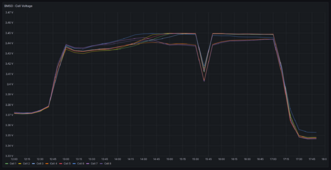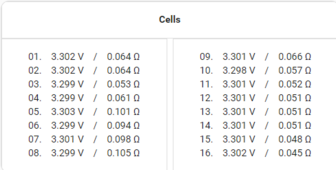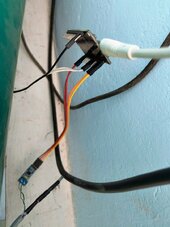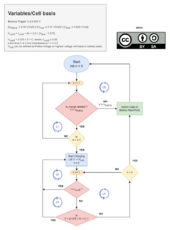FYI, The latest JK-BMS like the one I own have a 0% and 100% setting. I set 100% to 3.45V and 0% to 3.0V.
Exactly, older JK BMS, ≤ HW V 10.XW don't have the SOC calibration option
FYI, The latest JK-BMS like the one I own have a 0% and 100% setting. I set 100% to 3.45V and 0% to 3.0V.
It seems so. This is the level of overvoltage set on JK-BMS protection, overall 3.6 x 16 = 57.6V, which has never been reached on average. It's possible that one cell exceeds the 3.6V limit and triggers the alarm.
If I understand correctly, when the alarm is active, charging is stopped. Then the voltage drops, and the cycle starts again—Bulk -> Absorption -> alarm.
Easy, cell balancing.



If I understand correctly, when the alarm is active, charging is stopped. Then the voltage drops, and the cycle starts again—Bulk -> Absorption -> alarm.
What do you suggest to avoid this situation? Lower the bulk voltage level?
@Sleeper85
Battery at rest without large charge or discharge. What voltage does Deye and BMS display?
There may be a calibration problem.
@shvm
Exactly, older JK BMS, ≤ HW V 10.XW don't have the SOC calibration option
@shvm
Easy, cell balancing.


How can now repeat this process ?? does the JK BMS active balancer do the job ?
I have created on HA a simple "status" widget to monitor the adapter communication either CAN and BT
View attachment 192157
BT as reported (on Atom S3) seems quite stable
CAN has periodic disconnection/reconnection every 2h (quite regular)
Is this normal ?
Davide

Now I see !!!I understand where your problem comes from, you set your Start Balance V. to 3.0V, that's where all your problems come from.
You have broken your balance.
With a well-balanced battery, in production, the Start Balance V. should be at 3.45V if you charge at 55.2V.
Edit: I think it will be necessary to add a section in the README on how to configure JK-BMS
Super appreciatedThis is an experimental script with a blanching procedure.
line 972, if OVP => balancing = true
line 911, if balancing == true => charge with 55.2V and 5A max
line 937, if End Of Charge => balancing = false
The YAML was compiled for me but not tested.
Super appreciated
I will install it tomorrow after completing the test session on BLE stability on ESP32 Pico Atom Lite. I don't want to mix up so many tests and configurations.
So, just set again on the BMS, start the balance at 3.45V, and then enable the balancing function. How long does this process take via BMS (balance current 1A)
Yep, I don't see a reason why it wouldn't.I have a EG4 6000xp Lux Power coming in Thursday. Can I assume it would use the same protocol and battery settings as yours?
Yep, I did the same. You only need one pair like a telephone cable instead of the usual four pair in a CAT5E/6. Better make it already.Just need to make a cable for Can H/L for it.

Thank you very much for all these schemas, I will add them to the GitHub.
Could the Bluetooth version work with Atom Lite?
Or is it only for Atom S3?







@shvm If we replace that with tail current detection, at how many amps would you stop charging?

A: it's saferThis is interesting, what is the real gain compared to the timer?
Indeed. If a voltage above ~3.37 V is maintained across LFP Cell terminals with current below extrapolated cutoff, it is technically overcharging.Are you afraid of overcharging the battery?
Pretty much, yes. This happens to be an information complete charging model. There is no ambiguity, every situation regarding power, charging current and voltage is covered.This would be a big change to the script with lots of testing to validate it.
Agree about this being a strictly beta part.But maybe you can implement it yourself and if it works well I'll test it when I get back?
# +--------------------------------------+
# | CAN Protocol Settings |
# +--------------------------------------+
# CAN BMS Name (0x35E) : 0 NoSent / 1 PYLON / 2 GOODWE / 3 SEPLOS
can_bms_name: "1"
# CAN Protocol
# 1 : PYLON 1.2 (Deye)
# 2 : SEPLOS 1.0, PYLON 1.3, GOODWE 1.5 (GoodWe, Sol-Ark, Luxpower)
# 3 : SMA (Sunny Island, Sofar)
# 4 : VICTRON
can_protocol: "2"I am using 1.16.3. Downloaded 1/2hr before you updated to .4@ChrisG
V1.16.3 Sleeper85 : ID 0x379 will be sent when choosing protocol 2 or 4 (Battery Capacity for Victron, Sol-Ark and Luxpower)
YAML:# +--------------------------------------+ # | CAN Protocol Settings | # +--------------------------------------+ # CAN BMS Name (0x35E) : 0 NoSent / 1 PYLON / 2 GOODWE / 3 SEPLOS can_bms_name: "1" # CAN Protocol # 1 : PYLON 1.2 (Deye) # 2 : SEPLOS 1.0, PYLON 1.3, GOODWE 1.5 (GoodWe, Sol-Ark, Luxpower) # 3 : SMA (Sunny Island, Sofar) # 4 : VICTRON can_protocol: "2"
The version used is >= 1.16.3 with the CAN parameters as above in the YAML?
In the YAML, the default protocol is 1, you must define protocol 2 to send ID 0x379 for Luxpower (battery capacity).I am using 1.16.3. Downloaded 1/2hr before you updated to .4


